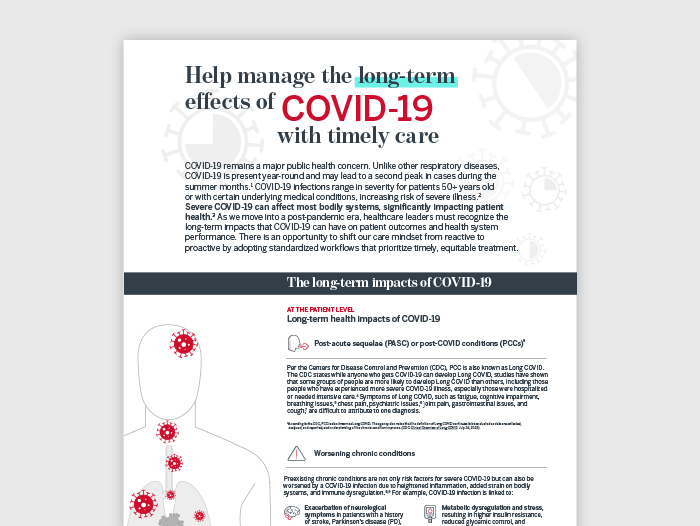Auto logout in seconds.
Continue LogoutAlthough research on long COVID is growing, much less is known about "long vax," or long-term symptoms after COVID-19 vaccination. This is a problem some researchers are working to remedy, writes Judy George for MedPage Today.
What is 'long vax'?
According to reports to the Vaccine Adverse Event Reporting System, some patients have experienced a variety of neurologic and systemic symptoms after receiving a COVID-19 vaccination. Some reported symptoms include post-vaccine neuropathy and tinnitus. Some vaccine recipients have also been diagnosed with postural orthostatic tachycardia syndrome (POTS), a condition that has also been diagnosed in long COVID patients.
However, Harlan Krumholz from the Yale School of Medicine and other researchers noted that "[i]mportantly, immune-mediated neurological adverse events post-vaccination are rare and often less severe than those that follow actual infection."
To better understand long-term symptoms that may occur after COVID-19 vaccination, Krumholz and his colleagues surveyed 241 adults who were part of the online LISTEN study from May 2022 to July 2023 and self-reported post-vaccination syndrome (PVS). Patients with long COVID were excluded from the study. So far, the study has only been posted on medRxiv and has not yet been peer reviewed.
Most of the participants were white women from the United States, and the median age was 46. Among the participants, 55% said they received the Pfizer-BioNTech vaccine, and 37% said they received the Moderna vaccine. A third (34%) also said that they had COVID-19 at least once.
Participants completed surveys between November 2022 and July 2023, a median of 595 days after being vaccinated. In the survey, participants used a list of 96 symptoms to identify any health conditions that had occurred due to a vaccine injury and reported their self-perceived health status on a five-point scale.
Participants also rated their quality of life on the Euro-QoL visual analogue scale (EQ-VAS) and reported symptom severity on their worst days. The symptom severity scale ranged from zero (trivial illness) to 100 (unbearable).
Overall, participants attributed a median of 22 symptoms to PVS, and 44% said their current health was fair or poor. The five most common reported symptoms were exercise intolerance (71%), excessive fatigue (69%), numbness (63%), brain fog (63%), and neuropathy (63%).
The median EQ-VAS score was 50. It was 52 among those without any previous comorbidities. Participants also reported a median symptom severity of 80.
The symptoms also negatively impacted the participants' mental health. In the week before taking the survey, many participants said they felt unease (93%), fearfulness (82%), and overwhelmed by worries (81%). They also reported feelings of helplessness (80%), anxiety (76%), depression (76%), or hopelessness (72%) at least once.
Participants tried a median of 20 treatments for their symptoms. The most common prescription therapies were oral steroids (48%), gabapentin (25%), low-dose naltrexone (20%), ivermectin (18%), propranolol (11%), and bronchodilators (11%).
Some of the non-drug treatments included limiting exercise or exertion (51% of participants), quitting alcohol or caffeine (44%), hydration and increasing salt intake (44%), and intermittent fasting (39%).
According to the researchers, some limitations of the study include the fact that patients were self-referred and self-reported their symptoms. "The participants are not representative, so it is not possible to estimate the incidence or who might be most susceptible to this condition," the researchers wrote.
Commentary
According to Krumholz, ongoing symptoms after COVID-19 vaccination are not often studied. "Even the definition of post-vaccination syndrome is in flux, but a working definition could be symptoms that begin with a week of a vaccination and persist for at least 2 months," he said.
The current study "raises awareness about what these individuals are experiencing and points attention to the need for more studies to understand what is underlying this condition and how to relieve suffering," Krumholz said.
Notably, "[t]hese people are not anti-vaxxers — they were all vaccinated — but because of politics, many have had the experience of being dismissed and ignored," Krumholz added.
Going forward, more research will be needed to better understand the effects of PVS. "The next step is to correlate what these people are experiencing with deep investigations of immune function," Krumholz said, adding that the LISTEN study is still recruiting participants. (George, MedPage Today, 12/1)
Develop a strong COVID-19 vaccine communication strategy that shares information, addresses patient concerns, and encourages uptake.
Don't miss out on the latest Advisory Board insights
Create your free account to access 1 resource, including the latest research and webinars.
Want access without creating an account?
You have 1 free members-only resource remaining this month.
1 free members-only resources remaining
1 free members-only resources remaining
You've reached your limit of free insights
Become a member to access all of Advisory Board's resources, events, and experts
Never miss out on the latest innovative health care content tailored to you.
Benefits include:
You've reached your limit of free insights
Become a member to access all of Advisory Board's resources, events, and experts
Never miss out on the latest innovative health care content tailored to you.
Benefits include:
This content is available through your Curated Research partnership with Advisory Board. Click on ‘view this resource’ to read the full piece
Email ask@advisory.com to learn more
Click on ‘Become a Member’ to learn about the benefits of a Full-Access partnership with Advisory Board
Never miss out on the latest innovative health care content tailored to you.
Benefits Include:
This is for members only. Learn more.
Click on ‘Become a Member’ to learn about the benefits of a Full-Access partnership with Advisory Board
Never miss out on the latest innovative health care content tailored to you.


